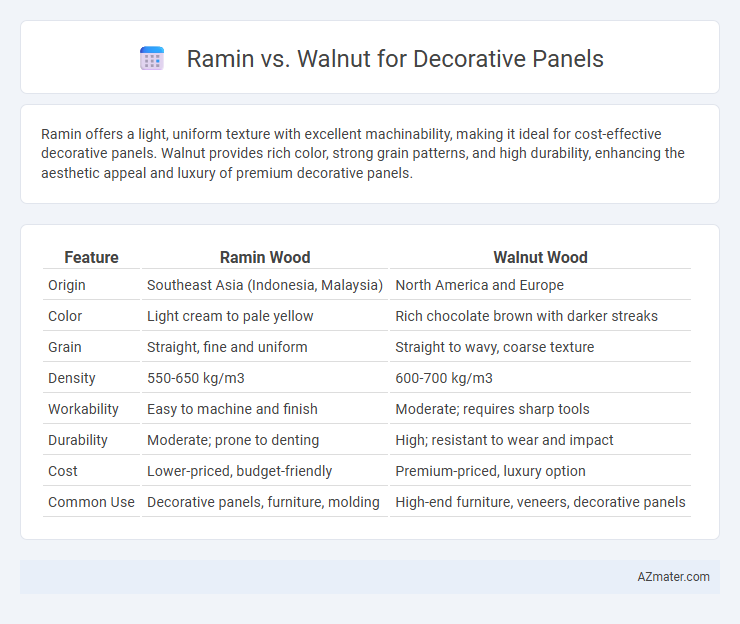Ramin offers a light, uniform texture with excellent machinability, making it ideal for cost-effective decorative panels. Walnut provides rich color, strong grain patterns, and high durability, enhancing the aesthetic appeal and luxury of premium decorative panels.
Table of Comparison
| Feature | Ramin Wood | Walnut Wood |
|---|---|---|
| Origin | Southeast Asia (Indonesia, Malaysia) | North America and Europe |
| Color | Light cream to pale yellow | Rich chocolate brown with darker streaks |
| Grain | Straight, fine and uniform | Straight to wavy, coarse texture |
| Density | 550-650 kg/m3 | 600-700 kg/m3 |
| Workability | Easy to machine and finish | Moderate; requires sharp tools |
| Durability | Moderate; prone to denting | High; resistant to wear and impact |
| Cost | Lower-priced, budget-friendly | Premium-priced, luxury option |
| Common Use | Decorative panels, furniture, molding | High-end furniture, veneers, decorative panels |
Introduction to Decorative Panel Materials
Ramin and walnut are popular wood choices for decorative panels, each offering distinct aesthetic and functional qualities. Ramin is a lightweight, pale hardwood known for its fine grain and smooth finish, making it ideal for sleek, modern interior designs. Walnut features rich, dark hues and intricate grain patterns that provide a luxurious, warm tone, often preferred for classic or high-end decorative panel applications.
Overview of Ramin Wood
Ramin wood, derived from the Shorea genus native to Southeast Asia, is celebrated for its fine texture, light color, and uniform grain, making it an excellent choice for decorative panels. Its moderate hardness and smooth finish offer superior machinability and allow for detailed carving and sanding compared to walnut's darker, more prominent grain. Ramin's consistent pale appearance enhances its versatility in various interior design styles, providing a sleek, modern aesthetic preferred in contemporary decorative wood paneling.
Overview of Walnut Wood
Walnut wood, prized for its rich color gradient ranging from creamy white to dark chocolate brown, offers exceptional durability and fine grain patterns ideal for decorative panels. Its natural luster and resistance to warping make it a preferred choice for high-end interior applications where aesthetic appeal and longevity are crucial. Compared to Ramin, walnut provides a more luxurious appearance and superior structural integrity, enhancing the overall value of decorative panel installations.
Visual Appeal: Grain and Color Comparison
Ramin wood offers a smooth, creamy texture with a subtle, straight grain that creates a clean and uniform appearance for decorative panels. Walnut features a rich, deep brown color with striking, varied grain patterns that add warmth and sophistication. Choosing between Ramin and Walnut depends on the desired visual effect, with Ramin providing light elegance and Walnut delivering bold, dramatic contrast.
Durability and Hardness Differences
Ramin wood exhibits moderate hardness with a Janka rating around 1,100 lbf, making it durable but softer compared to walnut, which rates approximately 1,010 lbf but often feels denser due to its tighter grain structure. Walnut's rich, deep color and fine grain add to its aesthetic appeal in decorative panels, whereas ramin offers a lighter tone suitable for bright, natural finishes. For applications demanding higher durability and resistance to dents, walnut generally outperforms ramin, although ramin's workability makes it a practical choice for intricate panel designs.
Workability and Finishing Qualities
Ramin wood offers superior workability for decorative panels due to its fine, uniform texture and straight grain, making it easy to cut, sand, and shape without splintering. Walnut presents excellent finishing qualities with a rich, deep color and natural luster that enhances decorative appeal, allowing smooth application of stains and varnishes. Both woods provide durable surfaces, but Ramin's lighter tone suits detailed carvings, while Walnut's hardness and color depth create a luxurious finish.
Sustainability and Environmental Impact
Ramin wood, sourced from Southeast Asia, faces increasing sustainability concerns due to overharvesting and habitat loss, making it less ideal for environmentally conscious decorative panels. Walnut, often harvested from sustainably managed forests in North America and Europe, offers a more eco-friendly option with lower environmental impact and better certifications such as FSC. Choosing walnut decorative panels supports responsible forestry and reduces biodiversity risks compared to ramin alternatives.
Cost and Market Availability
Ramin wood is generally more affordable than walnut, making it a cost-effective choice for decorative panels without compromising on quality. Walnut commands a higher price due to its rich grain and premium aesthetic, which is highly sought after in luxury interior design. Market availability for ramin is broader, especially in Southeast Asia, whereas walnut is more prevalent in North America and Europe, with seasonal fluctuations impacting supply.
Best Applications for Ramin vs Walnut Panels
Ramin panels excel in applications requiring lightweight and cost-effective solutions, often used in interior wall cladding, light furniture, and decorative accents due to their fine, even texture and pale yellow color. Walnut panels are ideal for premium settings where luxurious appearance and durability are prioritized, making them perfect for high-end furniture, feature walls, and cabinetry thanks to their rich, dark brown hues and attractive grain patterns. Choosing Ramin suits budget-conscious projects with moderate wear, while Walnut is the best option for long-lasting, visually striking decorative panels.
Choosing the Right Wood for Your Project
Ramin wood offers a light, consistent grain ideal for decorative panels seeking a smooth, modern finish, while walnut provides rich, dark hues with striking grain patterns that enhance luxury designs. Walnut's durability and natural resistance to wear make it suitable for high-traffic areas, whereas ramin's affordability and workability cater to budget-conscious or intricate detail projects. Selecting the right wood depends on balancing aesthetic preferences, project budget, and the panel's intended use environment to achieve the desired visual impact and longevity.

Infographic: Ramin vs Walnut for Decorative Panel
 azmater.com
azmater.com